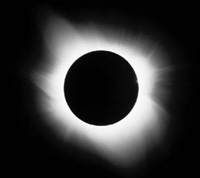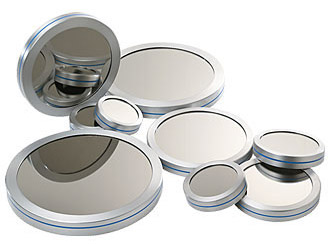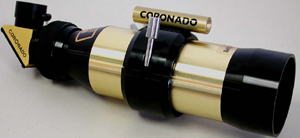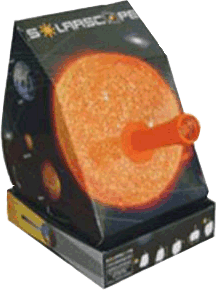|
Solar Viewing Safety:
A solar eclipse of any kind can be a once in a lifetime thrill that everyone
should be able to enjoy, but there is a right way to do it.
This page serves as a guide on how to view the
Sun safely.
THE SUN SHOULD NEVER BE VIEWED WITH THE EYE OR TELESCOPE
WITHOUT THE AID OF SPECIAL FILTERS - using a mirror to view a direct reflection
is the same as looking directly at the Sun. If you believe you have decreased
vision as a result of viewing the
Sun directly, see an eye care specialist
(Ophthalmologist) immediately. Unfortunately, damage to the retina from
direct Sun exposure is permanent and there is no treatment. This condition
is called Solar Retinopathy. I work in the eye care field as an ophthalmic
photographer and have seen this condition all to often.
Note: Solar Retinopathy is a condition that affects the central visual
acuity only - meaning the part of the eye (retina) that we use to read. While
total blindness will not occur, central blindness can occur.
However there is one, and only one, case in which the
Sun can be safely
viewed directly with the eye and that is during a
Total Solar
Eclipse. During a Total Solar Eclipse the
Moon covers the entire face of the
Sun preventing any direct sunlight from reaching the observer.
Using a
telescope with a special solar filter will allow direct viewing of
the Sun, and there are special
telescopes and tools that can be used to view the
Sun and image of the
Sun safely. But first, here are the three types of
Solar Eclipse
with a short narrative by me on safely viewing them. See the
Solar Viewing Equipment section below for
more information on how to safely view the
Sun.
For more information, please read NASA's
Eye Safety During Solar Eclipses.
NOTE: This is not to be confused with a
Lunar Eclipse,
which CAN be viewed with the eye.
 |
This is a
partial
solar eclipse. During a partial eclipse, the
Moon only covers a
portion of the
Sun - any position of the
Moon as long as the
Moon is not
directly in front of the
Sun. How much of the
Sun is covered depends on the
path of the
Moon. During a partial eclipse, there may be a noticeable
decrease in overall brightness but do not let that fool you as there is
still plenty of damaging sunlight that can burn the retina if viewed
directly. Safety requirements: use either solar eclipse
glasses, solar filters on a
telescope or a solar viewer device. NEVER
look at a partial eclipse with an unaided eye. Sunglasses will not help! |
 |
An
annular solar eclipse is seen here. In this case, the
Moon is
directly in front of the
Sun, but because of the elliptical orbit of the
Moon about the
Earth, it can be further away from us thereby looking
smaller - hence not covering the entire solar surface. It is probably OK
to look at the
Sun directly once the
Moon has covered the face of the
Sun, but I personally would advice against this. Safety
requirements: use solar eclipse glasses, solar filters on a
telescope or a solar viewer device. It might be safe to view the eclipse once the moon has covered the sun, but prudence reigns supreme. Total eclipse time can vary from a few
seconds to a minute or more so have your solar tools ready when the
Moon passes over the
Sun. |
 |
A
total solar eclipse is seen here. A total eclipse occurs when the
angular diameter of the
Moon equals the angular diameter of the
Sun (based on orbital motions of the
Moon) and the
Moon is able to cover the
entire face of the
Sun. During this time, the
Sun can safely be viewed
with the eye. But have your solar viewing gear ready as the
Moon takes a
few seconds to a few minutes to traverse the
Sun's face. Safety
requirements: use solar eclipse glasses, solar filters on a
telescope or a solar viewer device TO TRACK THE ECLIPSE until the
Moon covers the Sun's face. Total eclipse time can vary from a few
seconds to a minute or more so have your solar tools ready when the
Moon passes over the
Sun. |
I wish to repeat a statement made in the Safety Requirements above, and that
is using
Sun observing tools to track the path of the
Moon near the
Sun. Until
the
Moon fully covers the
Sun, these tools should be used for safety.
A Solar Eclipse is a wonderful phenomenon to behold. Viewing one safely by
using the right tools will ensure that you can enjoy the next Solar Eclipse!
And remember, unlike a
Solar Eclipse
a
Lunar Eclipse
does not require any observing aids.
Back to Top
Solar Viewing Equipment:
Solar safety is very important. Permanent blindness can occur of one looks
directly at the
Sun. Luckily there are several tools available for safely
viewing the
Sun:
- Solar Eclipse Glasses
- Solar Filters for binoculars and telescopes
- Specialized Solar telescopes
- Indirect viewing of the
Sun using a projection viewer
The Coronado
website has an excellent page on filter safety when viewing the
Sun with filters. I won't repeat it here but you can be directed to the page
here.
 |
A variety of companies offer a full aperture white light solar
filters that fits over the objective lens of a
telescope. Offered in a
variety of sizes, these filters block out 99.999% of all sunlight which
allows for safe viewing. Using these types of filters, viewing of the
Sun's surface with the eye and a camera is possible. Sunspots (if
present) will be visible.
The image on the left is an example from
Orion Telescopes, but other companies are:
Lumicon,
Thousand Oaks Optical,
Baader Planetarium and
Coronado. |
 |
Orion Telescopes offer a really interesting idea of white light
solar filters for binoculars. Just like the white light filters above,
they also block 99.999% of sunlight allowing for safe viewing of the
Sun. |
 |
Coronado
is a company that makes, what I believe is the only specialized Solar
Telescope. These utilize special filters called Hydrogen-Alpha filters
that allow spectacular views of the Sun's upper atmosphere. But beware,
they are expensive - but worth every penny! With this type of
telescope, direct solar viewing is possible. |
 |
Indirect viewing of the
Sun is probably the safest method available.
One uses a project to project the
Sun's image on a surface, and the
observer is simply viewing the reflection.
A perfect example of this is a product called
Solarscope. This uses the same principle as the shoebox camera (take
an empty shoebox, poke a hole on one end and use a piece of paper on the
other end to view the
Sun's image) but does it in a way that several
people can view at one time. |
Back to Top |

